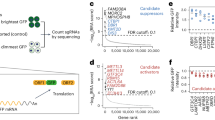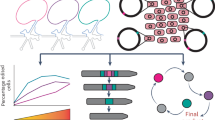Abstract
Alu elements are the most successful transposons in humans. They are 300-bp non-coding sequences transcribed by RNA polymerase III (Pol III) and are expected to retrotranspose with the aid of reverse transcriptases of cellular origin. We previously showed that human LINEs can generate cDNA copies of any mRNA transcript by means of a retroposition process involving reverse transcription and integration by the LINE-encoded endonuclease and reverse transcriptase. Here we show mobility of marked Alu sequences in human HeLa cells with the canonical features of a retrotransposition process, including splicing out of an autocatalytic intron introduced into the marked sequence, target site duplications of varying lengths and integrations into consensus A-rich sequences. We further show that the poly-A stretch at the Alu 3′ end is essential for mobility, that LINEs are required for transposition and that the rate of retroposition is 100–1,000 times higher for Alu transcripts than for control mRNAs, thus accounting for the high mutational activity of these elements observed in humans.
This is a preview of subscription content, access via your institution
Access options
Subscribe to this journal
Receive 12 print issues and online access
$209.00 per year
only $17.42 per issue
Buy this article
- Purchase on SpringerLink
- Instant access to full article PDF
Prices may be subject to local taxes which are calculated during checkout







Similar content being viewed by others
References
Lander, E.S. et al. Initial sequencing and analysis of the human genome. Nature 409, 860–921 (2001).
Weiner, A.M., Deininger, P.L. & Efstratiadis, A. Nonviral retroposons: genes, pseudogenes, and transposable elements generated by the reverse flow of genetic information. Annu. Rev. Biochem. 55, 631–661 (1986).
Deininger, P.L. SINEs: short interspersed repeated DNA elements in higher eucaryotes. in Mobile DNA (eds. Berg, D.E. & Howe, M.M.) 619–636 (American Society for Microbiology Press, Washington, D.C., 1989).
Boeke, J.D. & Stoye, J.P. Retrotransposons, endogenous retroviruses, and the evolution of retroelements. in Retroviruses (eds. Coffin, J.M., Hughes, S.H. & Varmus, H.E.) 343–435 (Cold Spring Harbor Laboratory Press, Cold Spring Harbor, New York, 1997).
Deininger, P.L. & Batzer, M.A. Mammalian retroelements. Genome Res. 12, 1455–1465 (2002).
Weiner, A.M. SINEs and LINEs: the art of biting the hand that feeds you. Curr. Opin. Cell Biol. 14, 343–350 (2002).
Schmid, C.W. Does SINE evolution preclude Alu function? Nucleic Acids Res. 26, 4541–4550 (1998).
Rowold, D.J. & Herrera, R.J. Alu elements and the human genome. Genetica 108, 57–72 (2000).
Batzer, M.A. & Deininger, P.L. Alu repeats and human genomic diversity. Nat. Rev. Genet. 3, 370–379 (2002).
Weiner, A.M. An abundant cytoplasmic 7S RNA is complementary to the dominant interspersed middle repetitive DNA sequence family in the human genome. Cell 22, 209–218 (1980).
Ullu, E. & Tschudi, C. Alu sequences are processed 7SL RNA genes. Nature 312, 171–172 (1984).
Quentin, Y. Fusion of a free left Alu monomer and a free right Alu monomer at the origin of the Alu family in the primate genomes. Nucleic Acids Res. 20, 487–493 (1992).
Sinnett, D., Richer, C., Deragon, J.M. & Labuda, D. Alu RNA secondary structure consists of two independent 7 SL RNA-like folding units. J. Biol. Chem. 266, 8675–8678 (1991).
Bovia, F. & Strub, K. The signal recognition particle and related small cytoplasmic ribonucleoprotein particles. J. Cell. Sci. 109, 2601–2608 (1996).
Deininger, P.L. & Batzer, M.A. Alu repeats and human disease. Mol. Genet. Metab. 67, 183–193 (1999).
Kazazian, H.H.J. An estimated frequency of endogenous insertional mutations in human. Nat. Genet. 22, 130 (1999).
Feng, Q., Moran, J.V., Kazazian, H.H. & Boeke, J.D. Human L1 retrotransposon encodes a conserved endonuclease required for retrotransposition. Cell 87, 905–916 (1996).
Cost, G.J. & Boeke, J.D. Targeting of human retrotransposon integration is directed by the specificity of the L1 endonuclease for regions of unusual DNA structure. Biochemistry 37, 18081–18093 (1998).
Cost, G.J., Feng, Q., Jacquier, A. & Boeke, J.D. Human L1 element target-primed reverse transcription in vitro. EMBO J. 21, 5899–5910 (2002).
Luan, D.D., Korman, M.H., Jakubczak, J.L. & Eickbush, T.H. Reverse transcription of R2Bm RNA is primed by a nick at the chromosomal target site: a mechanism for non-LTR retrotransposition. Cell 72, 595–605 (1993).
Jurka, J. Sequence patterns indicate an enzymatic involvement in integration of mammalian retroposons. Proc. Natl. Acad. Sci. USA 94, 1872–1877 (1997).
Esnault, C., Maestre, J. & Heidmann, T. Human LINE retrotransposons generate processed pseudogenes. Nat. Genet. 24, 363–367 (2000).
Kajikawa, M. & Okada, N. LINEs mobilize SINEs in the eel through a shared 3′ sequence. Cell 111, 433–444 (2002).
Esnault, C., Casella, J.F. & Heidmann, T. A Tetrahymena thermophila ribozyme-based indicator gene to detect transposition of marked retroelements in mammalian cells. Nucleic Acids Res. 30, e49 (2002).
Sisodia, S., Sollner-Webb, B. & Cleveland, D. Specificity of RNA maturation pathways: RNAs transcribed by RNA polymerase III are not substrates for splicing or polyadenylation. Mol. Cell. Biol. 7, 3602–3612 (1987).
Wallace, M.R. et al. A de novo Alu insertion results in neurofibromatosis type 1. Nature 353, 864–866 (1991).
Ullu, E. & Weiner, A.M. Upstream sequences modulate the internal promoter of the human 7SL RNA gene. Nature 318, 371–374 (1985).
Roy, A.M. et al. Upstream flanking sequences and transcription of SINEs. J. Mol. Biol. 302, 17–25 (2000).
Wei, W. et al. Human L1 retrotransposition: cis preference versus trans complementation. Mol. Cell. Biol. 21, 1429–1439 (2001).
Moran, J.V. et al. High frequency retroposition in cultured mammalian cells. Cell 87, 917–927 (1996).
Jensen, S. & Heidmann, T. An indicator gene for detection of germline retrotransposition in transgenic Drosophila demonstrates RNA-mediated transposition of the LINE I element. EMBO J. 10, 1927–1937 (1991).
Moran, J.V., DeBerardinis, R.J. & Kazazian, H.H. Jr. Exon shuffling by L1 retrotransposition. Science 283, 1530–1534 (1999).
Morrish, T.A. et al. DNA repair mediated by endonuclease-independent LINE-1 retrotransposition. Nat. Genet. 31, 159–165 (2002).
Chaboissier, M.C., Finnegan, D. & Bucheton, A. Retrotransposition of the I factor, a non-long terminal repeat retrotransposon of Drosophila, generates tandem repeats at the 3′ end. Nucleic Acids Res. 28, 2467–2472 (2000).
Roy-Engel, A.M. et al. Active Alu element “A-tails”: size does matter. Genome Res. 12, 1333–1344 (2002).
Martin, S.L. & Bushman, F.D. Nucleic acid chaperone activity of the ORF1 protein from the mouse LINE-1 retrotransposon. Mol. Cell. Biol. 21, 467–475 (2001).
Kolosha, V.O. & Martin, S.L. High-affinity, non-sequence-specific RNA binding by the open reading frame 1 (ORF1) protein from long interspersed nuclear element 1 (LINE-1). J. Biol. Chem. 278, 8112–8117 (2003).
Martin, S.L. Ribonucleoprotein particles with LINE-1 RNA in mouse embryonal carcinoma cells. Mol. Cell. Biol. 11, 4804–4807 (1991).
Hohjoh, H. & Singer, M. Cytolasmic ribonucleoprotein complexes containing human LINE-1 protein and RNA. EMBO J. 15, 630–639 (1996).
Sarrowa, J., Chang, D.Y. & Maraia, R.J. The decline in human Alu retroposition was accompanied by an asymmetric decrease in SRP9/14 binding to dimeric Alu RNA and increased expression of small cytoplasmic Alu RNA. Mol. Cell. Biol. 17, 1144–1151 (1997).
Muddashetty, R. et al. Poly(A)-binding protein is associated with neuronal BC1 and BC200 ribonucleoprotein particles. J. Mol. Biol. 321, 433–445 (2002).
West, N., Roy-Engel, A.M., Imataka, H., Sonenberg, N. & Deininger, P. Shared protein components of SINE RNPs. J. Mol. Biol. 321, 423–432 (2002).
Boeke, J.D. LINEs and Alu—the poly(A) connection. Nat. Genet. 16, 6–7 (1997).
Bovia, F., Fornallaz, M., Leffers, H. & Strub, K. The SRP9/14 subunit of the signal recognition particle (SRP) is present in more than 20-fold excess over SRP in primate cells and exists primarily free but also in complex with small cytoplasmic Alu RNAs. Mol. Biol. Cell. 6, 471–484 (1995).
Chang, D.Y., Sasaki-Tozawa, N., Green, L.K. & Maraia, R.J. A trinucleotide repeat-associated increase in the level of Alu RNA-binding protein occurred during the same period as the major Alu amplification that accompanied anthropoid evolution. Mol. Cell. Biol. 15, 2109–2116 (1995).
Willoughby, D.A., Vilalta, A. & Oshima, R.G. An Alu element from the K18 gene confers position-independent expression in transgenic mice. J. Biol. Chem. 275, 759–768 (2000).
Kimberland, M.L. et al. Full-length human L1 insertions retain the capacity for high frequency retrotransposition in cultured cells. Hum. Mol. Genet. 8, 1557–1560 (1999).
Heidmann, O. & Heidmann, T. Retrotransposition of a mouse IAP sequence tagged with an indicator gene. Cell 64, 159–170 (1991).
Tchénio, T. & Heidmann, T. The dimerization/packaging sequence is dispensable for both the formation of high-molecular-weight RNA complexes within retroviral particles and the synthesis of proviruses of normal structure. J. Virol. 69, 1079–1084 (1995).
Acknowledgements
We thank H. Kazazian, M. Wallace and E. Ullu for the L1-RP, Alu-NF1, and 7SL RNA gene plasmids, respectively; J. Maestre and P. Dessen for discussions; and C. Lavialle for comments and critical reading of the manuscript. This work was supported by the Centre National de la Recherche Scientifique and a grant from the Ligue Nationale Contre le Cancer (Equipe “labellisée”).
Author information
Authors and Affiliations
Corresponding author
Ethics declarations
Competing interests
The authors declare no competing financial interests.
Rights and permissions
About this article
Cite this article
Dewannieux, M., Esnault, C. & Heidmann, T. LINE-mediated retrotransposition of marked Alu sequences. Nat Genet 35, 41–48 (2003). https://doi.org/10.1038/ng1223
Received:
Accepted:
Published:
Issue Date:
DOI: https://doi.org/10.1038/ng1223



